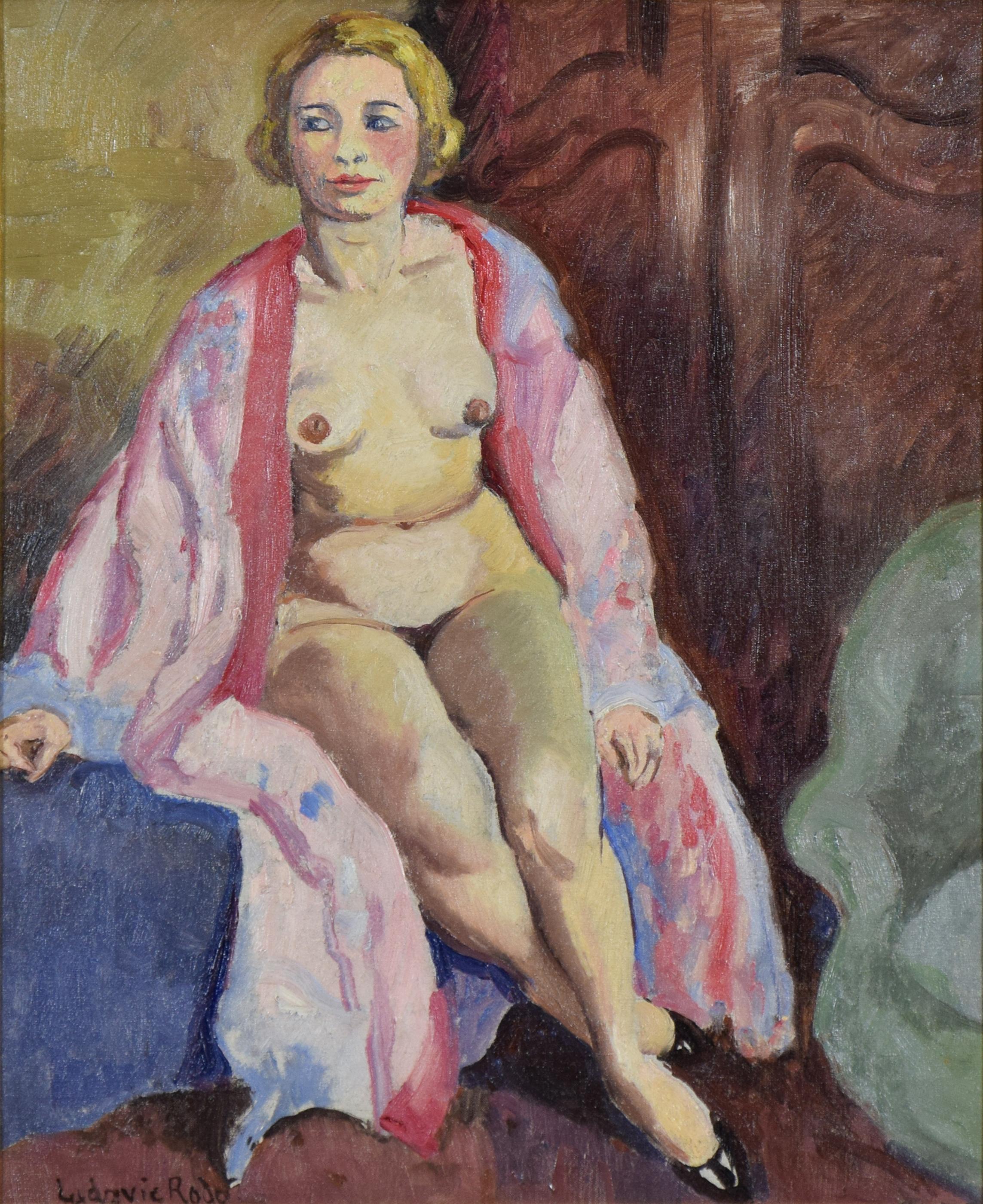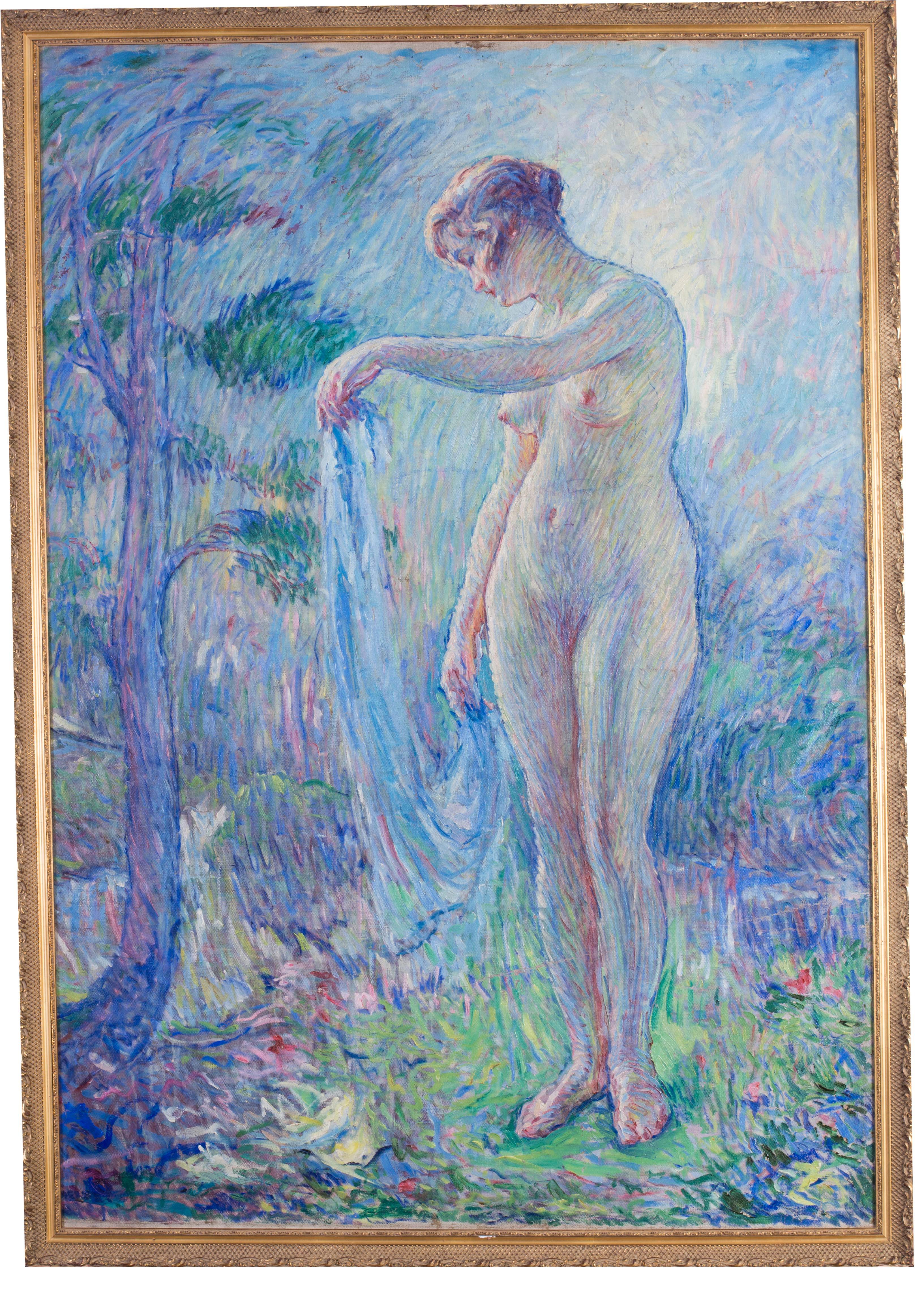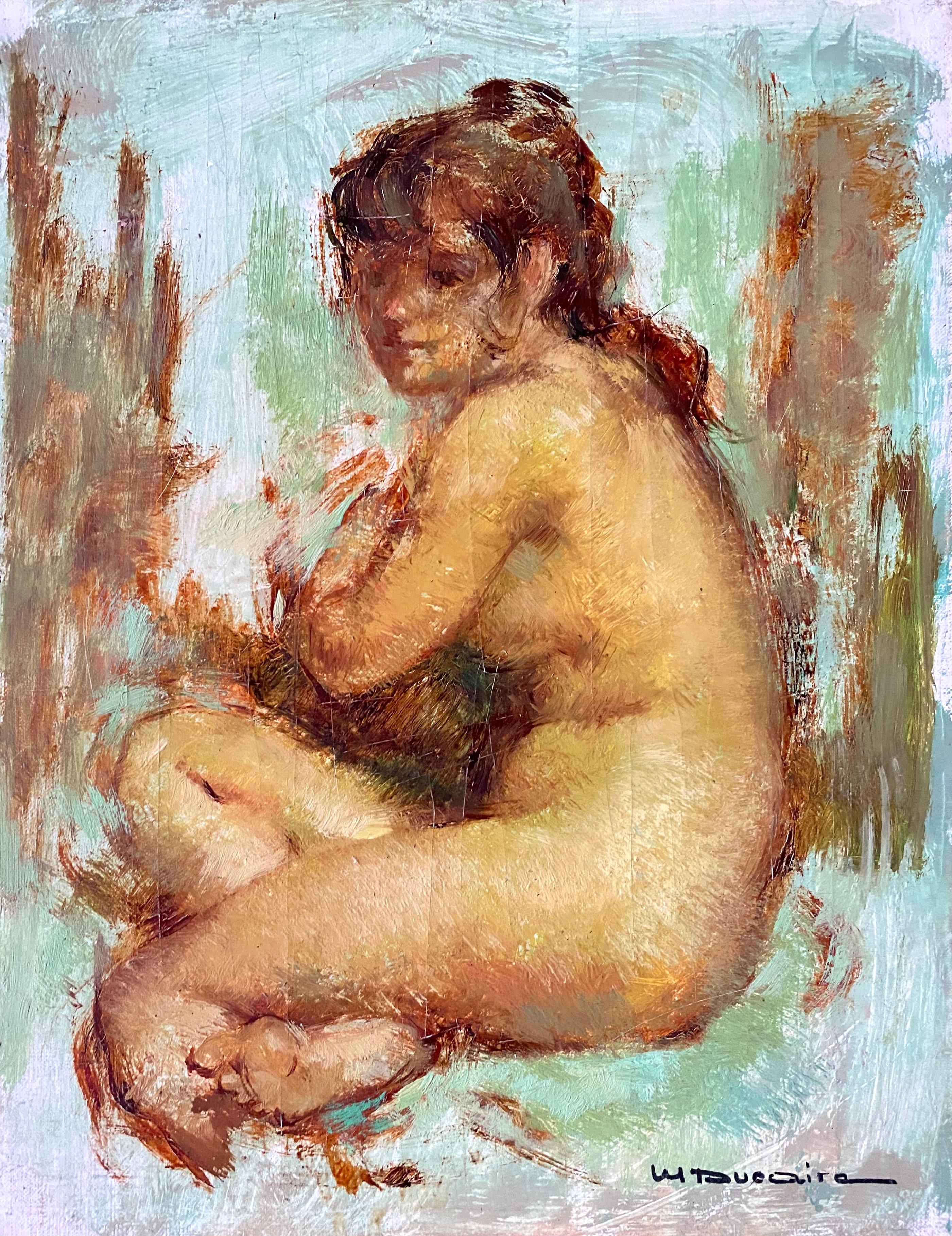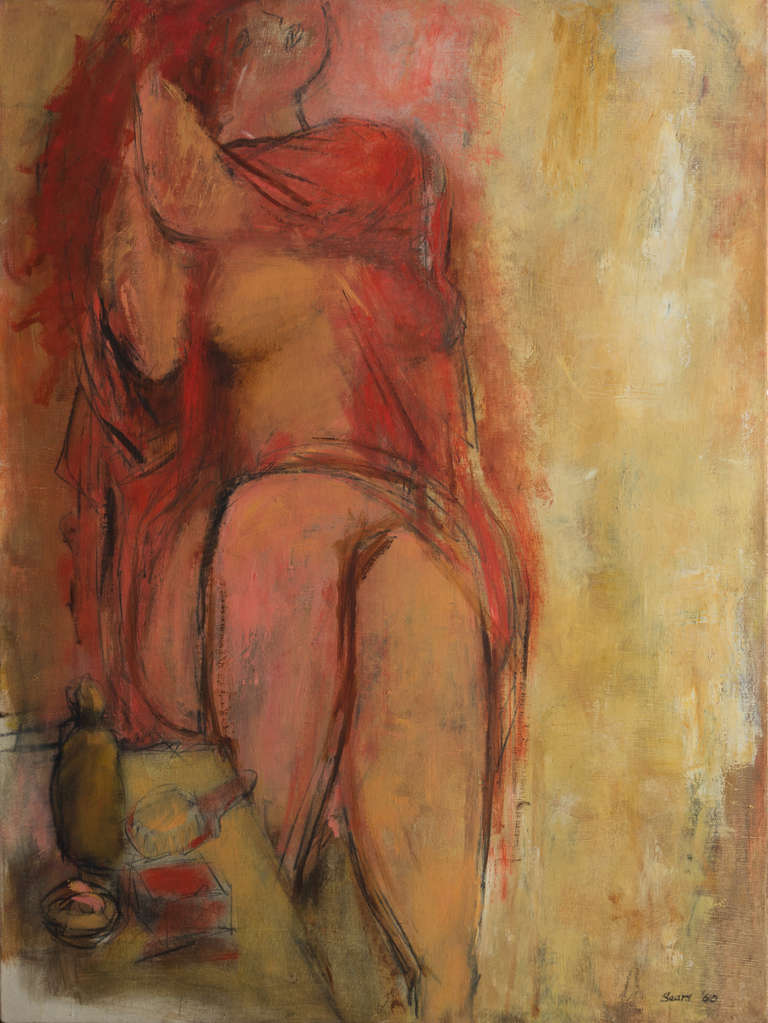Items Similar to Orientala By Reuven Rubin
Want more images or videos?
Request additional images or videos from the seller
1 of 8
Reuven RubinOrientala By Reuven Rubin20th century
20th century
About the Item
Reuven Rubin
Israeli | 1893-1974
Orientala
Signed “Reuven Rubin"
Oil on canvas
A striking and unique work rendered in a breathtaking jewel-toned palette, Orientala by Rueven Rubin showcases the dynamic artistry and singular point-of-view of the Israeli artist. While olive trees, sheep and fishermen were typical subjects for the artist, this rare work features the countenance of a woman. Considered a pioneering figurative Israeli artist of the mid-20th century, Rubin was a founder of the Eretz-Yisrael style alongside artists Nachum Gutman and Ziona Tajar. Rubin is celebrated for his portraits and sun-bleached modernist landscapes painted over the artist’s six-decade career spent living between Tel Aviv, New York, and Los Angeles.
Enigmatic and colorful, Orientala features a scantily clad woman wearing a turban-like headdress and holding a potted plant. Rubin renders the woman’s strong features in a plethora of non-naturalistic colors and with bold, angular brushstrokes. Reminiscent of works by Picasso, Jawlensky and even Chagall, Rubin employs a vivid and original palette along with striking modern techniques to create a composition that firmly establishes his own distinctive style.
Rubin Zelicovici, later Reuven Rubin, was born in Galaţi to a Romanian Jewish Hasidic family. In 1912, he left to study art at Bezalel Academy of Art and Design in Jerusalem. Finding himself at odds with the artistic views of the Academy's teachers, he left for Paris, France and began to cultivate his artistic vision. Influenced by artists like Cezanne, Rubin’s early depictions of his country’s landscapes rebelled against Bezalel and helped to establish Rubin as an internationally recognized artist. In 1924, he was the first artist to hold a solo exhibition at the Tower of David, in Jerusalem and that year he was elected chairman of the Association of Painters and Sculptors of Palestine. From the 1930s onwards, Rubin also designed backdrops for the Habima Theater and the Ohel Theater. Rubin’s work frequently explored themes of the biblical landscape, folklore and people in his works. Today, Rubin’s works are included in the collections of several major museums, including the Museum of Modern Art in New York City.
20th century
Canvas: 32” high x 26” wide
Frame: 44” high x 37 3/8”wide
Provenance:
The artist
Sam Salz, New York
Estate of Harold Weill, New York
Private Collection, New York
M.S. Rau, New Orleans
Literature:
Rubin: Retrospective Exhibition, The Tel Aviv Museum, Israel, July 1966, no. 49
Exhibitions:
Rubin: Retrospective Exhibition, The Tel Aviv Museum, July 1966, no. 49
Summer Times, The Tel Aviv Museum, Israel, July 26, 2021 - September 23, 2021
- Creator:Reuven Rubin (1893 - 1974, Israeli)
- Creation Year:20th century
- Dimensions:Height: 44 in (111.76 cm)Width: 37.38 in (94.95 cm)Depth: 3 in (7.62 cm)
- Medium:
- Movement & Style:
- Period:
- Condition:
- Gallery Location:New Orleans, LA
- Reference Number:
Reuven Rubin
Reuven Rubin- (November 13, 1893 - October 13, 1974) was a Romanian-born Israeli painter and Israel's first ambassador to Romania. Rubin Zelicovici (later Reuven Rubin) was born in Galaţi to a poor Romanian Jewish Hasidic family. He was the eighth of 13 children. In 1912, he left for Ottoman-ruled Palestine to study art at Bezalel Academy of Art and Design in Jerusalem. Finding himself at odds with the artistic views of the Academy's teachers, he left for Paris, France, in 1913 to pursue his studies at the École Nationale Supérieure des Beaux-Arts. At the outbreak of World War I, he was returned to Romania, where he spent the war years.
In 1921, he traveled to the United States with his friend and fellow artist, Arthur Kolnik, with whom he had shared a studio in Cernăuţi. In New York City, the two met artist Alfred Stieglitz, who was instrumental in organizing their first American show at the Anderson Gallery. Following the exhibition, in 1922, they both returned to Europe. In 1923, Rubin emigrated to Mandate Palestine.
Rubin met his wife, Esther, in 1928, aboard a passenger ship to Palestine on his return from a show in New York. She was a Bronx girl who had won a trip to Palestine in a Young Judea competition. He died in 1974.
About the Seller
5.0
Vetted Seller
These experienced sellers undergo a comprehensive evaluation by our team of in-house experts.
Established in 1912
1stDibs seller since 2013
15 sales on 1stDibs
Typical response time: 3 hours
- ShippingRetrieving quote...Ships From: New Orleans, LA
- Return PolicyThis item cannot be returned.
More From This SellerView All
- Le carnaval du sage by René MagritteBy René MagritteLocated in New Orleans, LARené Magritte 1898-1967 Belgian Le carnaval du sage (The Sage’s Carnival) Signed “Magritte” (lower right); titled and dated "Le carnaval du sage 1947" (en verso) Oil on canvas The enigmatic paintings of René Magritte have become some of the most familiar and celebrated of the Surrealist movement. Among the most influential of the Surrealist painters of the 20th century, Magritte is an artist of international renown, as beloved for his popular appeal as he is for the psychological intensity of his works. The present oil on canvas, entitled Le carnaval du sage, was executed in 1947 at the height of his career, and it is a tour-de-force example of the haunting, mysterious scenes that comprise his oeuvre. Painted in the years following the Second World War, Le carnaval du sage showcases several recurring themes from Magritte’s oeuvre. Chiefly, a juxtaposition between the visible and the hidden is keenly felt. Throughout his career, Magritte explores the psychological obsession with revealing what is hidden, particularly with regard to the human face. In his Le fils de l’homme, he obscures the face of a man in a bowler hat with an apple, while his Les amants (Metropolitan Museum of Art) conceals the faces of two lovers with white sheets. In Le carnaval du sage, Magritte juxtaposes the blatant nudity of his central figure by masking her face, simultaneously revealing and concealing her from the viewer. The work also incorporates two of Magritte’s most common tropes – the glass of water and the baguette. Lending the scene a strange sense of domesticity, they appear infinitely familiar and distinctly out of place, and thus heighten the uncanny effect of Magritte’s composition. In the background hovers a ghost obscured by a sheet, a figure which was of particular fascination to Magritte beginning in 1946. He once wrote to his fellow Surrealist Paul Nougé: "I saw in a dream an answer to the problem of the ghost: the traditional ghost draped...Category
20th Century Post-Impressionist Nude Paintings
MaterialsCanvas, Oil
- SolitudeBy Guillaume SeignacLocated in New Orleans, LAFrench Academic painter Guillaume Seignac was renowned for his masterful treatment of the idealized nude. His languishing female subjects based on Greco-Roman prototypes were and rem...Category
19th Century Academic Nude Paintings
MaterialsOil, Canvas
- SalomeLocated in New Orleans, LAThis compelling portrait of Salome was composed by the French painter Marie Felix Hippolyte-Lucas. While the celebrated artist's oeuvre is filled with bright and cheerful portraits of aristocratic women surrounded by florals, here he takes a different approach. Hippolyte-Lucas' Salome is simultaneously exotic and highly modern, rendered in a style that is both theatrical and bold. The monumental work's rich color palette is filled with gem-inspired hues that lend drama to the scene, highlighting the blatant sexuality of this legendary seductress. Though Salome is not named in the New Testament, she has appeared time and time again in art and literature over the centuries, as both an innocent and a seductress. Her mother, Herodias, resented John the Baptist, who denounced her marriage to King Herod as unlawful. At one evening meal, Salome danced...Category
19th Century Other Art Style Nude Paintings
MaterialsCanvas, Oil
- Baigneuses (Bathers)By Louis-Joseph CourtatLocated in New Orleans, LAFrench Academic painter Louis-Joseph Courtat displays his mastery of composition and the female form in this entrancing oil on canvas. Entitled Baigneuses, the work was painted for and exhibited at the 1885 Paris Salon, the foremost exhibition of painters in the Western world. Large in size, it captures two nude bathers within a tranquil beach scene. While the artist's skill for landscape painting is on display, it is his command of form, light and color that bring this canvas to life. The artist specialized in paintings that glorified the nude, and his skill is clear in the luminosity of his models' skin and the classical beauty of their form and proportions. With their soft, undulating curves and flowing hair, Courtat's models reflect the two key influences on the young painter, that of the great Jean-Auguste-Dominique Ingres as well as his teacher Alexandre Cabanel. Like these two greats who came before him, Courtat similarly follows in the artistic tradition of the female nude that is traceable to classical antiquity and the Italian Renaissance. Born in Paris in 1847, Courtat studied at the famed École des Beaux-Arts under Cabanel. He was one of the Academic master's first students at the school, where he began to teach in 1864. Displaying considerable skill at an early age, Courtat won the Prix de Rome around 1870, and subsequently studied in Rome for a number of years. He returned to Paris in 1873 to make his debut at the Salon, where he was met with immediate success, receiving a third class medal. He received medals again in 1874 and 1875, a remarkable achievement for a painter of his age. In addition to the monumental nudes...Category
19th Century Academic Nude Paintings
MaterialsCanvas, Oil
- Italian Panel with Satyr and NymphsLocated in New Orleans, LAThis extraordinary Italian gouache and oil on canvas brings two of the most popular characters from Greek mythology vividly the life - the nymph and the satyr. Both creatures are famed for their carefree natures and lascivious temperaments, and tales abound of satyrs pursing nubile nymphs in order to rape or seduce them, usually with little success. One such narrative humorously unfolds in the present piece, which depicts an indignant satyr captured by three nymphs with a golden net. The relationship between these two mythological creatures was a popular one for artists throughout the 18th and 19th centuries, though its origins stretch back to antiquity. Both satyrs and nymphs...Category
Early 19th Century Other Art Style Figurative Paintings
MaterialsCanvas, Oil, Gouache
- SolitudeBy Guillaume SeignacLocated in New Orleans, LASigned “G-Seignac” (lower right) Oil on canvas French Academic painter Guillaume Seignac was renowned for his masterful treatment of the idealized nude. His languishing female subje...Category
19th Century Academic Nude Paintings
MaterialsOil, Canvas
You May Also Like
- Nu Assise by Ludovic-Rodo Pissarro - Nude paintingBy Ludovic-Rodo PissarroLocated in London, GBNu Assise by Ludovic-Rodo Pissarro (1878-1952) Oil on canvas 55 x 47 cm (21 ⅝ x 18 ½ inches) Signed lower left, Ludovic Rodo Executed circa 1910 This work is accompanied by a cer...Category
1910s Fauvist Nude Paintings
MaterialsCanvas, Oil
- Large French Post Impressionist painting of a nude with blue tones by MalherbeBy William MalherbeLocated in Petworth, West SussexWilliam Malherbe (French, 1884 – 1955) La Baigneuse Oil on canvas 51 x 35.1/2 in. (130 x 90 cm.) William Malherbe was a French Post Impressionist painter born in 1884. His success c...Category
Early 20th Century Post-Impressionist Nude Paintings
MaterialsCanvas, Oil
- “Resting Female Nude”By Maryse Ducaire RoqueLocated in Southampton, NYBeautifully executed original oil on canvas painting by the French artist, Maryse Ducaire-Rogue of a seated female nude. Signed by the artist lower right. Condition is good. Circa ...Category
1970s Post-Impressionist Nude Paintings
MaterialsOil, Canvas
- 'Seated Nude', Paris, Louvre, Academie Chaumiere, Carmel, California, LACMA, OilBy Victor Di GesuLocated in Santa Cruz, CAStamped, verso, with the estate stamp for Victor Di Gesu (American, 1914-1988) and painted circa 1958. A substantial, Post-Impressionist style figural oil showing a young woman seat...Category
1960s Post-Impressionist Nude Paintings
MaterialsCanvas, Oil
- 'Nude in Ivory and Coral', Large Mid-Century Expressionist Figural OilBy Sears, Roebuck & CompanyLocated in Santa Cruz, CASigned lower right "Sears" (American, 20th century) and dated 1960. A substantial, Expressionist style figural oil showing a partially-draped woman seated at a dressing-table and br...Category
1960s Post-Impressionist Nude Paintings
MaterialsCanvas, Oil
- 'Seated Nude', Paris, Salon d'Automne, Royal Danish Academy, Expressionist OilLocated in Santa Cruz, CASigned lower right, 'Rob Leepin' for Robert Leepin (Danish, 1884-1967) and painted circa 1925. Robert Leepin first studied under Lauritz Tuxen and Viggo Johansen at Denmark's Royal ...Category
1920s Post-Impressionist Nude Paintings
MaterialsOil, Canvas
Recently Viewed
View AllRead More
Wear Louis Comfort Tiffany’s Genius on Your Finger with This Vivid Ring
In his jewelry making, the designer rarely used diamonds — this rare example has two.
You Won’t Find a More Handsome Stopwatch Than This 1890s Pocket Chronograph
A Grand Complication from the golden era of pocket watches, the Marius Lecoultre pocket watch does everything but uncork your wine.






